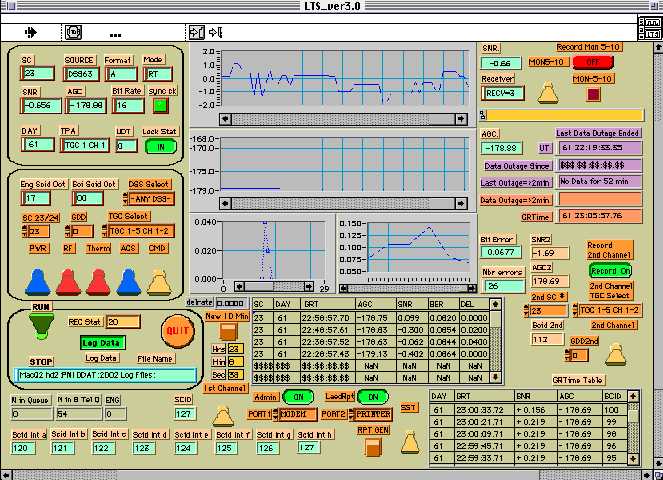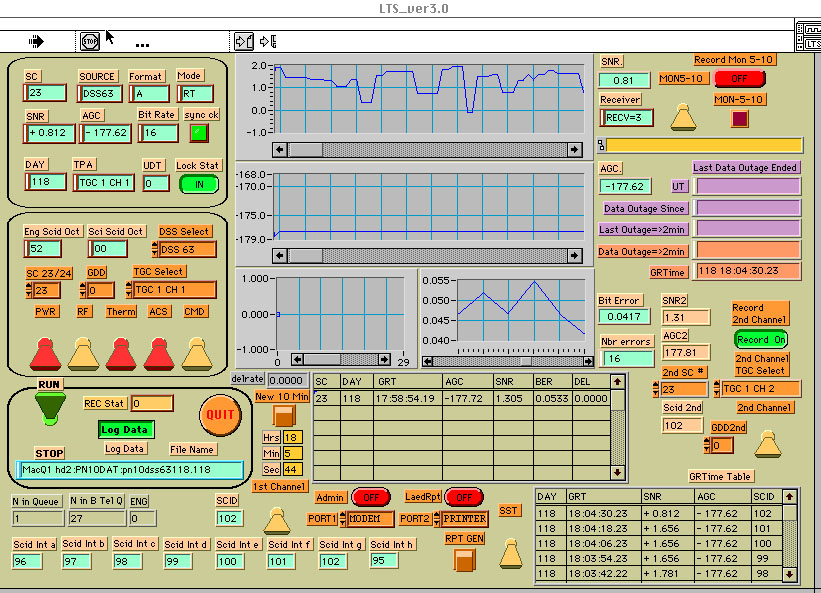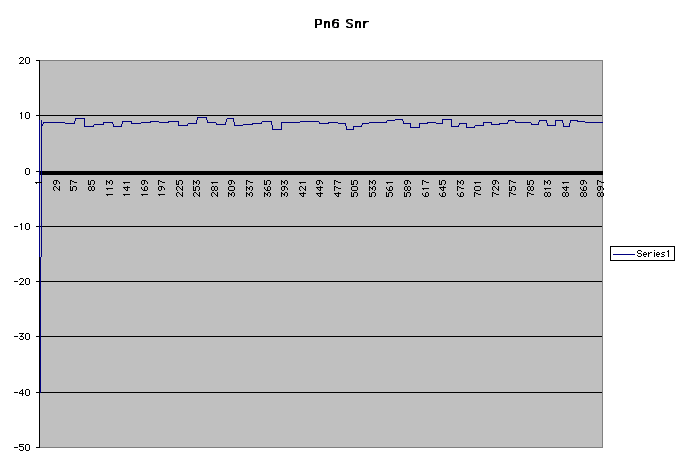

STATUS UPDATED: 24 November 2004
Pioneer 10 distance from Sun : 86.83 AU Speed relative to the Sun: 12.173 km/sec (27,231 mph) Distance from Earth: 12.85 billion kilometers (7.98 billion miles) (Round-trip Light Time = 23 hours 49 minutes)
GOLDSTONE
On 1 March 2002, DSS 14 transmitted an uplink, and two no-op commands at 200 kw to the spacecraft.
MADRID
22 hours later, from 79.4 AU, DSS 63 acquired the downlink on time at -183 dbm. After peaking the signal to -178.5 dbm, they locked the telemetry at 16 bps with SNR of -0.5 db.
ARICEBO
SETI Institute also acquired the same signal at Puerto Rico. SETI has been using Pioneer 10 as a reference signal.
Very cold with most temperature readings at the bottom of their scale. Bus voltage about 26 volts (nominal is 28). Uplink received from DSS 14 at -131.7 dbm. Two commands received, both confirmed as executed. Geiger Tube Telescope Instrument on, and data received.

Project Phoenix has been observing Pioneer 10 at Arecibo in Puerto Rico through the auspices of the SETI Institute. The signal from Pioneer 10 was also picked up at Arecibo on 2 March 2002.
The last telemetered data from the University of Iowa cosmic ray instrument were as follows: 2 March 2002 (39 minutes of clean data) (r = 79.83 AU) 27 April 2002 (33 minutes of clean data) (r = 80.22 AU)
At GMT 17:27:30, Saturday, 4/28/01, the signal from Pioneer 10 was received at station 63 in Madrid, the first time since August 5/6 of 2000. So it appears that Pioneer 10 has life, albeit in another mode - i.e., only in a two-way coherent mode. We have been listening for the Pioneer 10 signal in a one-way downlink non-coherent transmission mode since last summer with no success. We therefore conclude that in order [for Pioneer 10] to talk to us, we need to talk to it. This means from now on, we need two-way round-trip light time (RTLT) passes to allow the Deep Space Network (DSN) to send up a strong stable signal to lock up with a coherent downlink signal.

Hear Pioneer Speaks
Pioneer 6 was featured on the Star Date radio broadcast by the University of Texas McDonald Observatory on 16 December 2000 - the 35th anniversary of its launch. Pioneer 6 is the oldest NASA spacecraft extant.
There was a successful contact of Pioneer 6 for about two hours on 8 December 2000 to commemorate its 35th anniversary. The control room at NASA Ames Research Center in Mountain View, CA, was manned by Project Manager: Larry Lasher, Flight Director: Dave Lozier, Chief Flight Controller: Ric Campo, and Flight System Engineer; Larry Kellogg, with Network Operations Project Engineer: Ida Millner at JPL. Some 35 years from the launch date of 12/16/65, Pioneer 6 telemetry data were received expeditiously as spacecraft lockup occurred on the first attempt on Day 344 UT 0000:45 (local time 4:00:45 PM PST) at DSS-14 at Goldstone. Pioneer 6 was 83 million miles distant from Earth. The track lasted approximately 2.5 hours. The Signal-to-Noise Ratio (SNR)=9 dB and signal strength (AGC)=-164 remain at approximately the same levels as the last previous contact in October 6, 1997 demonstrating the stability and durability of NASA's oldest extant spacecraft. Viva la Pioneer.

PIONEER 10 HONORED BY STAMP! On November 18, 1999 the US Postal Service issued a stamp commemorating the Pioneer 10 spacecraft . It was selected as one of the 15 icons for the decade of the 1970s as part of its Celebrate the Century postage stamp series. The US Postal Service consulted with the Pioneer Project Manger to ensure its accuracy. The following inscription was chosen for the stamp: Launched March 1972, "Pioneer 10" was the first spacecraft to travel to an outer planet, providing data and images of Jupiter. Eleven years later, it became the first man-made object to leave the solar system.
This is not the first time the US Postal Service has commemorated Pioneer 10. A stamp was also issued in 1974.
PIONEER 10 DEFLECTED BY A KUIPER BELT OBJECT? Preliminary results indicate that Pioneer 10 has had an encounter with a Trans-Neptunian object at 56 AU. Using coherent radio Doppler data generated by the Deep Space Network (DSN) at S band frequencies (wavelength ~ 13 cm), PN 10 experienced a gravitational deflection in December 1992. The new body, found by a team at Queen Mary and Westfield College in London, UK, and the Jet Propulsion Laboratory in California, is probably a so-called Kuiper Belt object. If the observations are confirmed by other astronomers, it will be only the second time in history that a Solar System object has been discovered by its gravitational effect alone. The first was the planet Neptune which was discovered in 1846. Its position was predicted because of its gravitational tug on the planet Uranus, which appeared to be behaving oddly following its discovery 59 years earlier.
This story was reported by BBC News Online Science Editor Dr David Whitehouse on 28 September 1999
ANOMALOUS GRAVITATIONAL FORCE? A discussion of this phenomenon appears in the 4 October 1999 issue of Newsweek magazine (See also the December 1998 issue of Scientific American.) The mystery of the tiny unexplained acceleration towards the sun in the motion of the Pioneer 10, Pioneer 11 and Ulysses spacecraft remains unexplained. A team of planetary scientists and physicists led by John Anderson (Pioneer 10 Principal Investigator for Celestial Mechanics) has identified a tiny unexplained acceleration towards the sun in the motion of the Pioneer 10, Pioneer 11, and Ulysses spacecraft. The anomalous acceleration - about 10 billion times smaller than the acceleration we feel from Earth's gravitational pull - was identified after detailed analyses of radio data from the spacecraft. A variety of possible causes were considered including: perturbations from the gravitational attraction of planets and smaller bodies in the solar system; radiation pressure, the tiny transfer of momentum when photons impact the spacecraft; general relativity; interactions between the solar wind and the spacecraft; possible corruption to the radio Doppler data; wobbles and other changes in Earth's rotation; outgassing or thermal radiation from the spacecraft; and the possible influence of non-ordinary or dark matter. After exhausting the list of explanations deemed most plausible, the researchers examined possible modification to the force of gravity as explained by Newton's law with the sun being the dominant gravitational force. "Clearly, more analysis, observation, and theoretical work are called for," the researchers concluded. The scientists expect the explanation when found will involve conventional physics.
An article as part of SPACE.com's weekly Monday series discusses the current thinking on the acceleration anomaly.
Pioneer 10 will continue into interstellar space, heading generally for the red star Aldebaran, which forms the eye of Taurus (The Bull). Aldebaran is about 68 light years away and it will take Pioneer over 2 million years to reach it.
(Launched 5 April 1973)
The last communication from Pioneer 11 was received in November 1995, shortly before the Earth's motion carried it out of view of the spacecraft antenna.
The spacecraft is headed toward the constellation of Aquila (The Eagle), Northwest of the constellation of Sagittarius. Pioneer 11 will pass near one of the stars in the constellation in about 4 million years.
Question:
Question:
Question:
Question:
Question:
Question:
Question:
The radio signal transmitted from an antenna on Earth is focused and reflected by the spacecraft dish antenna toward a small feed horn located on a tripod which is centered in front of the spacecraft dish antenna, and then conducted to a receiver in the spacecraft. During a CONSCAN maneuver, the feed horn is physically moved by 8 inches to one side. A ground command turns on a heater in a bellows filled with liquid Freon. The Freon boils, the bellows expands, and moves a mechanical piston and cam attached to the feed horn mounting plate against a mechanical stop. A micro switch cycles the heater power on and off to keep the feed in the offset position.
With the feed in the offset position, the radio signal from the tracking station is seen by the spacecraft receiver as varying sinusoidally in amplitude (amplitude modulated). This error signal contains amplitude and phase information on the pointing angle between the spacecraft spin axis and the Earth and the direction to the Earth during the spin cycle. The minimum amplitude occurs during the spin cycle when the antenna points to the Earth, whereas the maximum occurs when the antenna dish points away from the Earth. The frequency of the modulation is equal to the spacecraft spin rate (4.28 rpm). The error signal is processed on board the spacecraft to calculate the timing requirements for firing the jets at the appropriate instant in the spin cycle to precess the spin axis towards the Earth.
The CONSCAN processor averages the modulation over two revolutions of the spacecraft. On the third revolution, it orders two hydrazine thrusters (mounted 180 degrees apart on the rim of the dish antenna) to fire a short pulse of 0.0312 seconds duration. This moves the spacecraft spin axis a tiny amount toward the minimum amplitude value, i.e., the Earth, reducing the amplitude of the modulation by a small amount. This process is repeated each three revolutions, each time reducing the pointing angle error and the modulation amplitude. When the pointing angle is within 0.3 degrees of boresight, the processor terminates the maneuver automatically. Typically, about 20 to 28 pulses are fired. A ground command then executes to turn off the power to the feed offset heater, the gaseous Freon recondenses to pull the mechanism back to the normal centered position, and the maneuver is completed.
Question: